Heating scheme from a gas boiler in a two-story house: a review and comparison of the best heating schemes
Are you building a new one or repairing an old house, and has it come to the heating system? Not sure which type of wiring is best to choose? A properly designed heating scheme from a gas boiler in a two-story house is a guarantee not only of warmth and comfort in the winter, but also of the smooth operation of the equipment.
A competent heating project takes into account many factors - from climate and financial capabilities, to the need for fine-tuning and aesthetic issues. In this article we will analyze in detail all the possible types of heating systems, give and compare ready-made schemes with the most successful set of parameters for different cases, and also indicate the possibility of their modification.
The content of the article:
Types of private gas heating systems
There are many parameters that determine the type of heating system, gas boiler selection as the main heat generator - this is only the first step. It is possible to equip the heating circuit by connecting all the devices with one pipe, or conduct separate supply and return lines.
Also, the structure of the system depends on the heating devices used, such as an expansion tank, layout and area of the house. In addition, you can divide the system into several separate circuits and provide for the possibility of natural circulation in the event of a blackout, and much more.
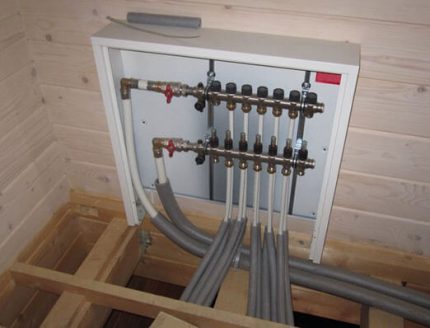
We will consider in more detail all the possibilities, advantages and disadvantages of each type of system below.
One and two pipe connection schemes
Within these two types, 5 connection schemes can be distinguished.
Consider them in increasing order of complexity and cost:
- Simple single pipe.
- One-pipe "Leningradka".
- Double pipe dead end.
- "Tichelman's loop."
- Collector, or beam scheme.
The simplest single pipe connecting radiators implies that the coolant enters the second radiator only after the first has passed, and so on. A warm floor can also be included in such a system - it is connected last, from the return of the farthest battery.
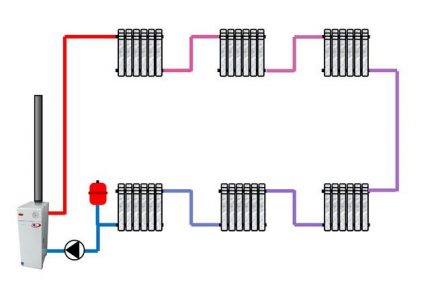
A simple one-pipe scheme can not only be compiled and calculated, but also mounted independently. In addition, it is easy to equip with the possibility of natural circulation.
However, such a system has a serious drawback: the temperature with each battery decreases markedly, and it is impossible to adjust it. If the temperature control valve limits the flow temperature to the first radiator, the temperature in all decreases proportionally - only the increase in the number of sections of the last radiators partially helps.
But in two-story houses, as a rule, the area is substantial and the systems are too long for such a scheme to work productively. Due to the inability to configure a simple one-pipe system is practically not used.
An improved single-pipe scheme, the so-called "Leningradka", provides bypass on each radiator. Thus, part of the coolant passes by the radiator, and the hotter mixture gets into the next.

If you add taps and temperature controllers to the circuit, you get a system that is average in price and functionality between a simple one-pipe and two-pipe - a fairly popular solution.
A two-pipe system involves the separation of supply and return into two separate pipes, connected to each radiator. Materials will be required much more, but the hot coolant will not mix with the return, and therefore it will effectively warm a much larger number of batteries.
Dead-end branches are conveniently laid where there is no way to ring the room with pipes, for example, because of the balcony door. The direction of the flows in the supply and return is obtained in the opposite direction, and therefore there is a chance that the water will go along the path of least resistance and close the circulation circle through the first radiator, but will not get into the rest at all.
The problem is solved by using balancing valves, as well as pipes of a smaller section for connecting to a radiator than for highways.
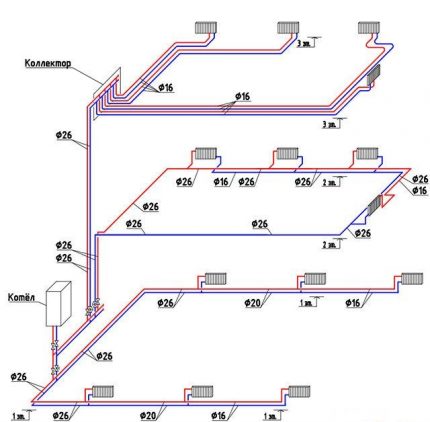
Tihelman's loop is the most successful and popular solution in terms of cost-effectiveness ratio. Its difference is that the flow direction in the supply and return is parallel, therefore, no matter what battery the coolant goes through, the length of the circulation circle will be the same, the path of least resistance does not exist. As a result, all batteries are heated evenly, but each of them can be separately adjusted or completely turned off without affecting the operation of the system.
The collector circuit implies the presence of two collectors, for supply and return, from which pairs of pipes to each heating device are separated by rays. For best performance collector positioned so that the distance from it to each heating appliance is approximately the same. Usually, a separate collector is installed on each floor.
Only in such a system will the coolant of the same temperature be supplied to each battery, and it is the one that is easiest to control and change the heating power of individual points.
The main disadvantage of the beam connection scheme is the need for a large number of pipes, which not only increases the cost, but also complicates the installation. On the other hand, the connection of such systems is completely hidden, and it looks aesthetically pleasing.
Another important point - the collector system, unlike all the previous ones, cannot be gravitational. This means that even with a non-volatile boiler, the heating will turn off as soon as the lights turn off and the pump stops.
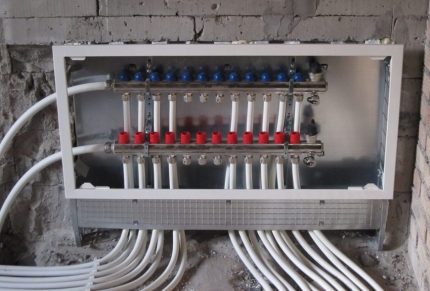
Often in two-story houses, different heating distribution schemes are used for different rooms, depending on their layout, area and heating devices used.
In a two-story house, single-tube projects with a single supply pipe are practically not used, because the last radiators in the circuit work extremely inefficiently. Depending on the area of the house, individual contours correspond to each floor, several or even each room.
It is also customary to separate the radiator circuit from the warm floor, due to the need for different operating pressures and temperatures.
The division of the feed from the boiler into different circuits can be carried out through a hydraulic arrow, a collector, or a combination thereof. The first provides flows of different pressure and temperature for different systems, the second is effective for circuits with the same type of devices, for example, radiation connection of radiators.
Open and closed systems
This parameter indicates whether there is a contact of the coolant with air, and is determined by the type expansion tank.
The expansion tank compensates for the increase in fluid volume during heating, preventing the increase in pressure in the system. The open type tank has an opening on top and works simply due to the stock of volume, filling up to different levels. So that water from it does not overflow according to the principle of communicating vessels, such a tank should be installed at the highest point of the system. In a two-story house, as a rule, this is the top of the feed riser.
The disadvantages of such a system are many. The coolant is in contact with open air, which means it evaporates and enriches with oxygen. As a result, it is forbidden to fill such a system with antifreeze, water will need to be regularly added, and excess air constantly provokes corrosion and air congestion. In addition, when removed to the attic, the tank requires thorough insulation, and in a room on 2 floors it is problematic to disguise it.
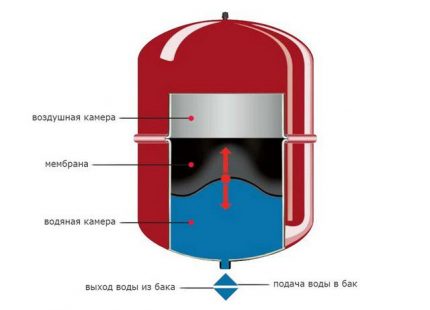
The closed expansion tank is sealed, consists of two chambers separated by a membrane. It works due to the ability of air to compress: when the system is heated, water occupies most of the tank, the pressure in the air chamber rises. When cooling, it is this pressure that pushes water back into the system.
Such an expansion tank can be installed anywhere in the system, most often on the return line, in front of the pump. The system with a closed tank is absolutely tight, it can even be filled with a toxic solution of ethylene glycol. Even ordinary water under these conditions is gradually purified from impurities and dissolved gases, turning into an almost ideal coolant.
By type of heating appliances
Different devices can be included in one heating system: radiators, floor heating, convectors and others. They can be combined even within the simplest single-tube scheme, but with a gravitational type of circulation it is better to use ordinary batteries.
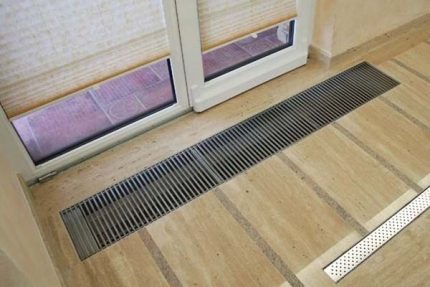
A warm floor is not only pleasant and convenient, but also economical, since warm air fills the lower, residential part of the room, and cools down under the ceiling. This decision is especially irreplaceable if there is a child in the house. They are also often installed in the bathroom and in the kitchen.
Systems consisting only of underfloor heating, can only be equipped in well-insulated buildings and in a temperate climate, otherwise it will be cool in the cold in the house or it will be impossible to walk on the red-hot floor. As a rule, warm floors with a small number of radiators are combined in one scheme - this is both beautiful, economical, and convenient.
Radiators are most popular for good reason: they work both on the radiation of heat from the outer plane, warming up the air and objects in front of them, and according to the convection principle, passing air through the ribs.
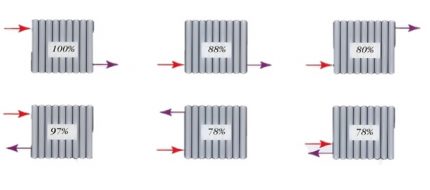
The main disadvantage of traditional batteries is the difficulty of their placement without violating the interior design, because any camouflage screens reduce efficiency.
By type of coolant circulation
Water or antifreeze through the system most often moves from the circulation pump: it creates the necessary pressure, providing fast, efficient and uniform heating. However, the presence of a pump makes any system volatile - that is, in the event of a power outage, the heating will also turn off.
An alternative is gravity systems. They are designed in such a way that the coolant circulates due to an increase in density during cooling, and also under the force of gravity due to the slope of all pipes of the circuit.
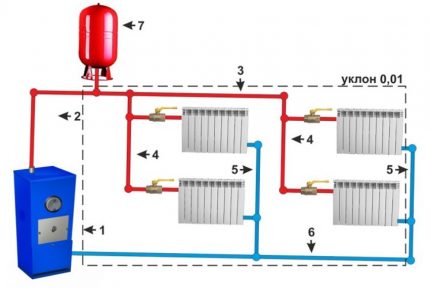
Such a heating scheme for a private two-story house with a non-volatile gas boiler will work even if the electricity is not connected at all, but the circulation speed, and hence the efficiency, will be much lower. In addition, a slow flow leaves much more sediment on the walls of the system.
The ability of systems with natural circulation to self-adjust is interesting: the colder in the house, the faster the coolant cools in the batteries, the difference in the supply and return temperatures increases, which means the flow rate and the heating efficiency.
If regular blackouts are a harsh reality, and the house is small, the best solution is a system with a mixed type of circulation. Its plan should be calculated, as for a gravitational system - with pipe slopes, a boiler at a lower point, etc.
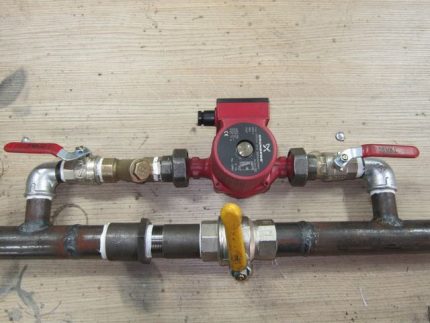
It is possible to install underfloor heating in such a system, but they will only work when the pump is on.
Horizontal and vertical wiring
In a two-story house, it will not be possible to manage only with horizontal pipelines - at least one riser must supply the coolant to the second floor. But the type of wiring as a whole does not change this.
Horizontal wiring can be performed within each floor. With it, pipes connect all radiators of the same level to a single circuit. It is the most versatile and popular, can be implemented with any layout.

Imagine a one-pipe vertical wiring simply by the example of an apartment building heating system. The layout of each floor, including the location of the radiators, perfectly matches them.Each battery is connected by a riser to the same from the neighbors from below and above, but there are no horizontal heating pipes in the apartment.
If in your house the layout allows you to place all the radiators exactly one above the other, the vertical circuit will work more efficiently, especially with the gravitational type of circulation. In addition, risers are easier to disguise than horizontal piping.
However, during the installation of the system, it will be necessary to cross the floors many times, and this is more difficult than passing the pipe through the wall.
Additional equipment - advantages and disadvantages
Any heating circuit can be improved by adding temperature control valves for adjusting the operation of each battery, thermostats, a hydraulic arrow, a circulation pump for each circuit, and other additional devices.
Mayevsky cranes and air vents at the top of each riser are mandatory in systems with a closed expansion tank. Each additional device makes the system more efficient, more economical, and enables finer and more convenient settings.
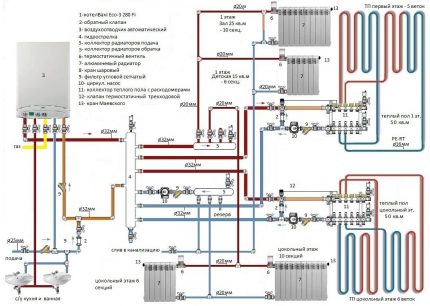
Use only the necessary components, because the smaller the units, the lower the probability of one of them leaving the system and stopping the system.
The best schemes for a two-story house
In each case, it is necessary to develop an individual heating project that will ensure efficient and economical operation.
To make the right choice, you should consider such factors:
- climate and quality of building insulation;
- number and purpose of premises. Does constant and uniform heating are everywhere needed;
- the stability of power supply and the availability of a generator largely determine the type of circulation;
- individual wishes of residents - warm floors or walls in separate rooms or throughout the house, etc.
- room layout - whether perimeter wiring is feasible;
- design requirements and stage of repair. In many cases, all pipes, and sometimes heating appliances can be hidden in the floor and walls;
- budget - the estimate for the arrangement of heating in one building may differ many times and tens of times.
Having answered all these questions, and knowing the features of different schemes, you will get an idea of the necessary option.
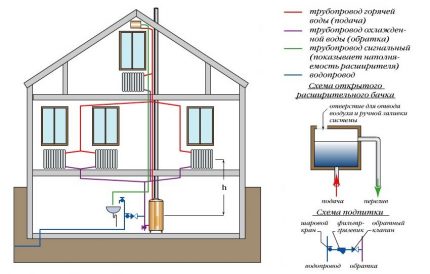
Next, we suggest choosing one of the proven effective schemes for connecting heating devices to the boiler and adjusting it according to your layout.
One-pipe Leningradka - reliable and cheap
Such a one-pipe scheme is one of the cheapest, simplest and oldest, but relevant and popular to this day. Using only radiators allows for a mixed type of circulation in case of a blackout. To do this, the gas boiler must be non-volatile, all pipes should go with a slope of 5 - 10 mm per 1 meter.
To facilitate the adjustment, you can put thermostats on the supply of each battery, control valves on the bypass of the batteries. An additional valve on the riser will make it possible to turn off the heating circuit of a separate floor.
Underfloor heating can be included in the system as a separate, third circuit, or replace radiators on one floor. However, in this case, the division of the flows should pass through a thermal mixer or hydraulic arrowso that the floor does not heat up in frosts to 70 - 80 ° C, like batteries.
Also note that when the power is turned off, only the batteries will work, and in a strictly horizontal floor heating circuit, the coolant will stand idle.
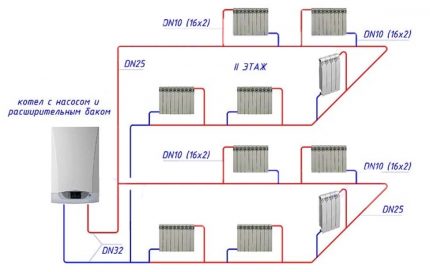
The main limitation when arranging such a system concerns a heated area: a house more than 100 m2 Does not warm up with natural circulation of the coolant. Such a system will save only from defrosting pipes and breaking the boiler heat exchanger during a long shutdown, but not from the cold.
In addition, even with forced circulation, such a heating circuit is almost impossible to configure if it includes more than 5 - 7 batteries. That is, for ease of use in a large house, it is necessary to break the circuit into a larger number of circuits.
Read more about the arrangement of a one-pipe heating system Leningradka can be found in this stuff.
Tichelman loop with forced circulation
As we already mentioned, this connection scheme provides the most efficient operation and convenient adjustment of each radiator at a relatively low cost of materials.
The system can cover the whole house with one loop, be divided into 2 circuits by floors, as in the diagram, or used only for one floor or part of it.
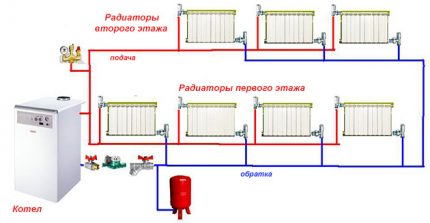
Modern radiator heating systems are often equipped according to such a plan, if it is possible to mask the pipeline. In addition, devices of different types can be included in one circuit: radiators, convectors, thermal curtains.
Collector Connection and Mixed Systems
Using a collector to separate not only heating circuits, but also to individually connect each device is the most modern and convenient solution to use.
It has several advantages:
- beautiful - all pipes are hidden in the floor and walls;
- convenient - adjustment of any device in the manifold cabinet;
- efficiently - an equally hot coolant is supplied to all devices, but each of them heats exactly as much as you need;
- universal - devices of different types can be connected to one collector, regardless of layout.
The main disadvantage of this solution is the high cost of both materials and installation. Pipes will be needed much more than for any other connection scheme, and laying communications on the floor, especially if the concrete screed is already flooded, will cost a lot.
It is also worth considering that such a connection completely eliminates the possibility of natural circulation.
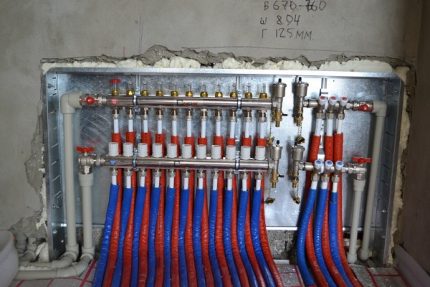
In two-story houses, as a rule, one collector is installed in the center of each floor, but with a large number of heating appliances and collectors it can be more. For underfloor heating systems use separate collectors, with a lower coolant temperature.
Vertical gravity diagram
In addition to the standard options described, more exotic ones are found, like a vertical two-pipe with natural circulation. Perhaps this is the best solution for a two-story house, in which the lights are often turned off.
Due to the fact that in a vertical system water circulates more easily than in a horizontal one, and a large expansion tank under the roof acts as a collector, the most efficient and uniform heating is ensured even without using a pump.
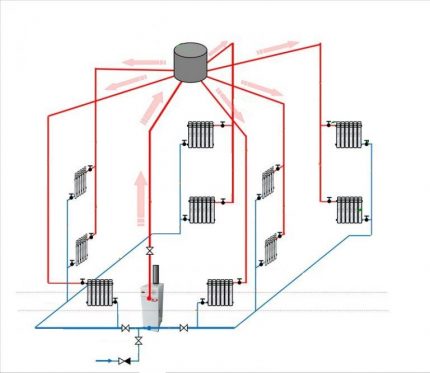
The pipe for supplying hot water to the expansion tank and the return line must be the thickest; the risers supplying the 2nd floor are slightly thinner, their lower part, on the 1st floor - even smaller diameter, and the radiator connection pipes with the smallest cross-section.
Conclusions and useful video on the topic
You can see how the two-pipe scheme is implemented in practice in a 2-story building in this video:
You can find out about arranging a combined system with radiators and a warm floor here:
And this video is useful to those who are going to equip heating with a gravitational or mixed type of circulation:
Summing up, we can say that an ideal and universal heating scheme does not exist: in each case, it is necessary to take into account many factors and prioritize. We tried to describe all available options to make the choice easier and more correct.
And what is the heating scheme in your house? How satisfied are you with her and what would you like to change? Join the discussion below.

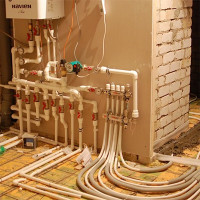 Optimal wiring of heating in a private house: a comparison of all typical schemes
Optimal wiring of heating in a private house: a comparison of all typical schemes 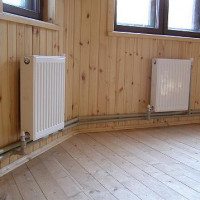 Steam heating in a private house and in a country house based on a stove or boiler
Steam heating in a private house and in a country house based on a stove or boiler 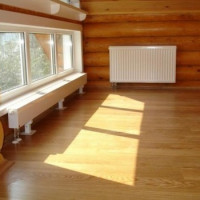 Heating in a wooden house: a comparative overview of suitable systems for a wooden house
Heating in a wooden house: a comparative overview of suitable systems for a wooden house 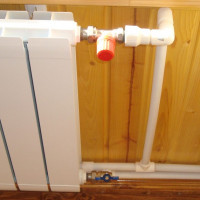 Two-pipe heating system of a private house: device diagrams + overview of the advantages
Two-pipe heating system of a private house: device diagrams + overview of the advantages 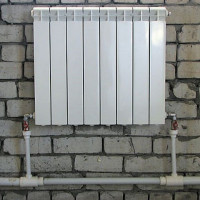 One-pipe heating system of a private house: schemes + an overview of the advantages and disadvantages
One-pipe heating system of a private house: schemes + an overview of the advantages and disadvantages 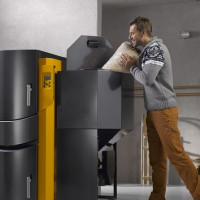 Pellet boiler binding: diagrams, installation and connection rules for the pellet boiler
Pellet boiler binding: diagrams, installation and connection rules for the pellet boiler  How much does it cost to connect gas to a private house: the price of organizing gas supply
How much does it cost to connect gas to a private house: the price of organizing gas supply  The best washing machines with dryer: model rating and customer tips
The best washing machines with dryer: model rating and customer tips  What is the color temperature of light and the nuances of choosing the temperature of the lamps to suit your needs
What is the color temperature of light and the nuances of choosing the temperature of the lamps to suit your needs  Replacement of a geyser in an apartment: replacement paperwork + basic norms and requirements
Replacement of a geyser in an apartment: replacement paperwork + basic norms and requirements